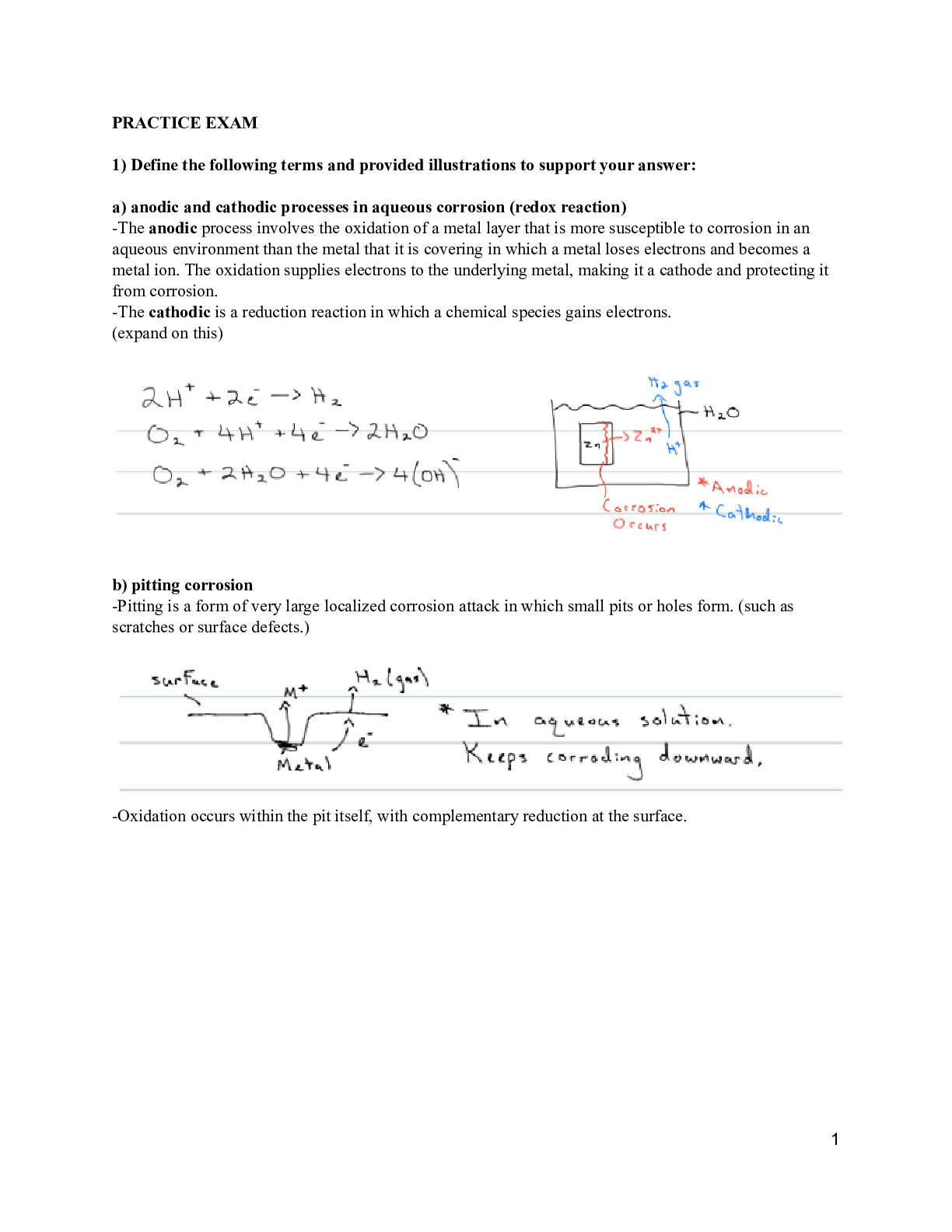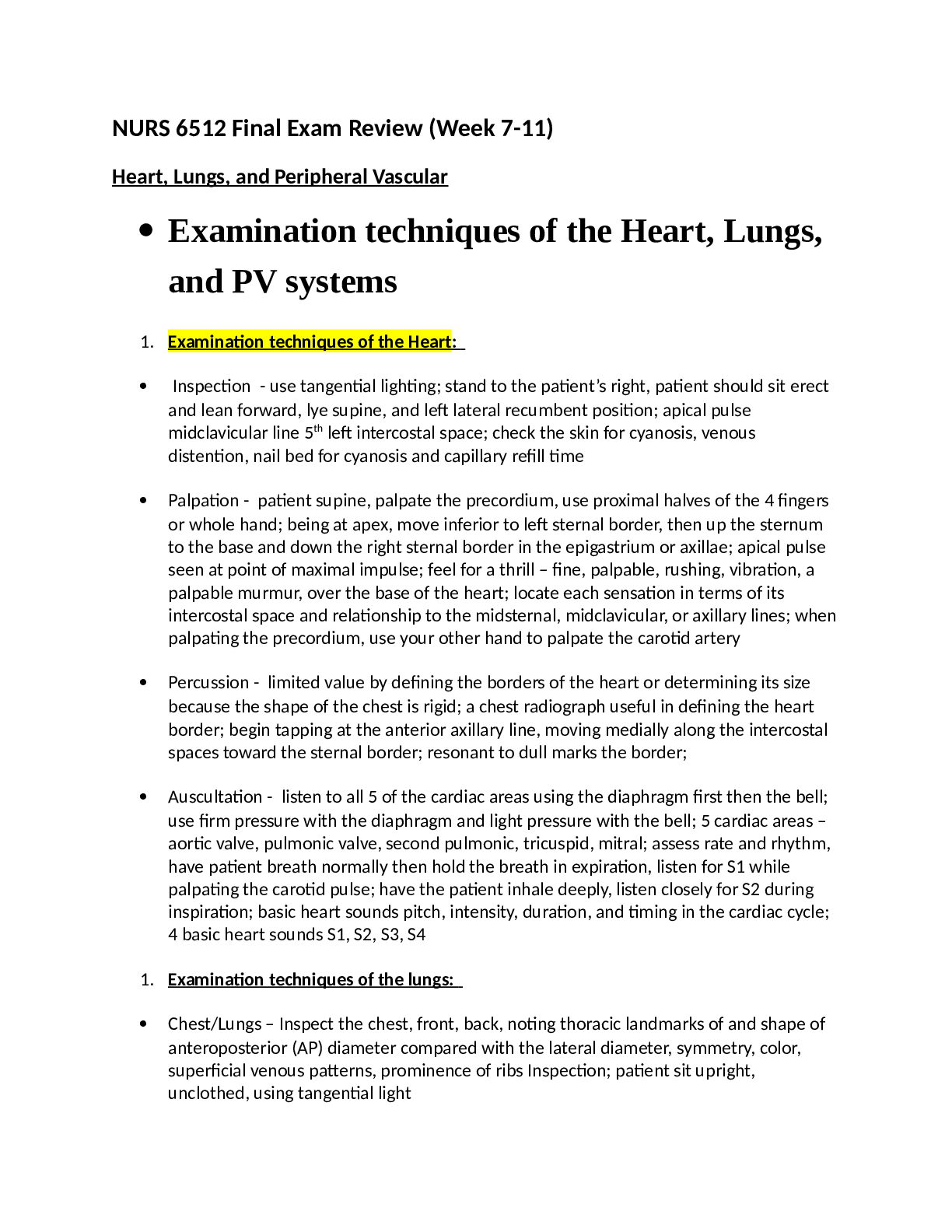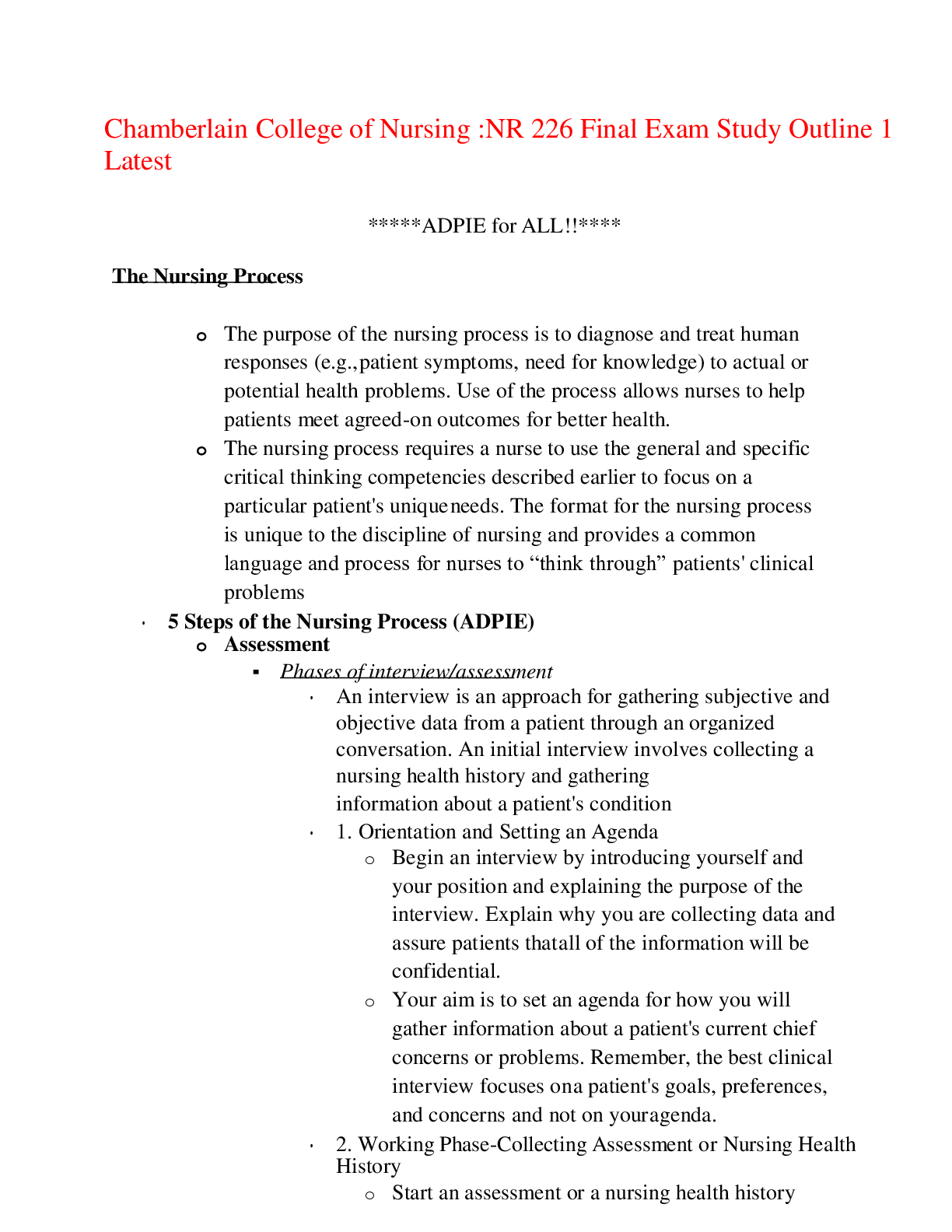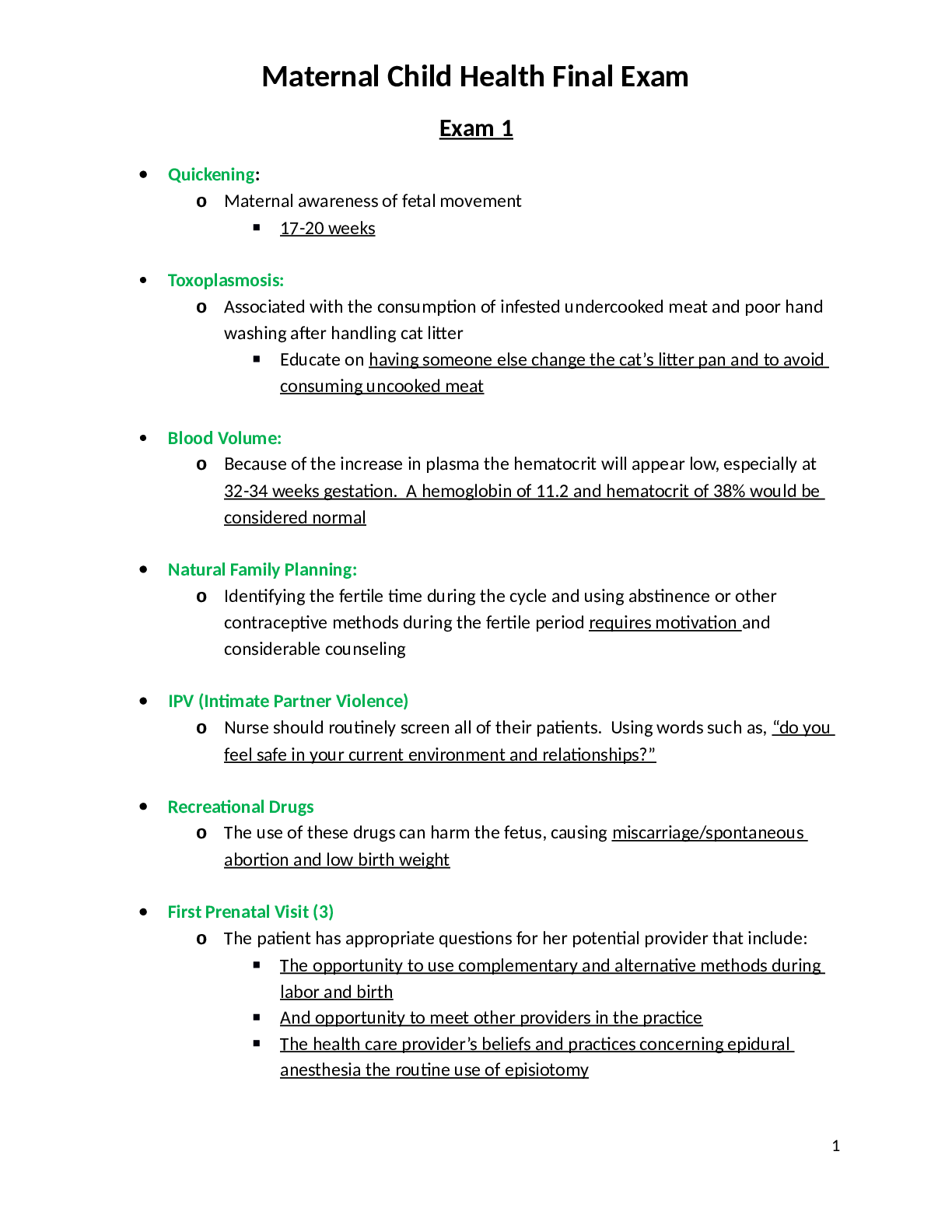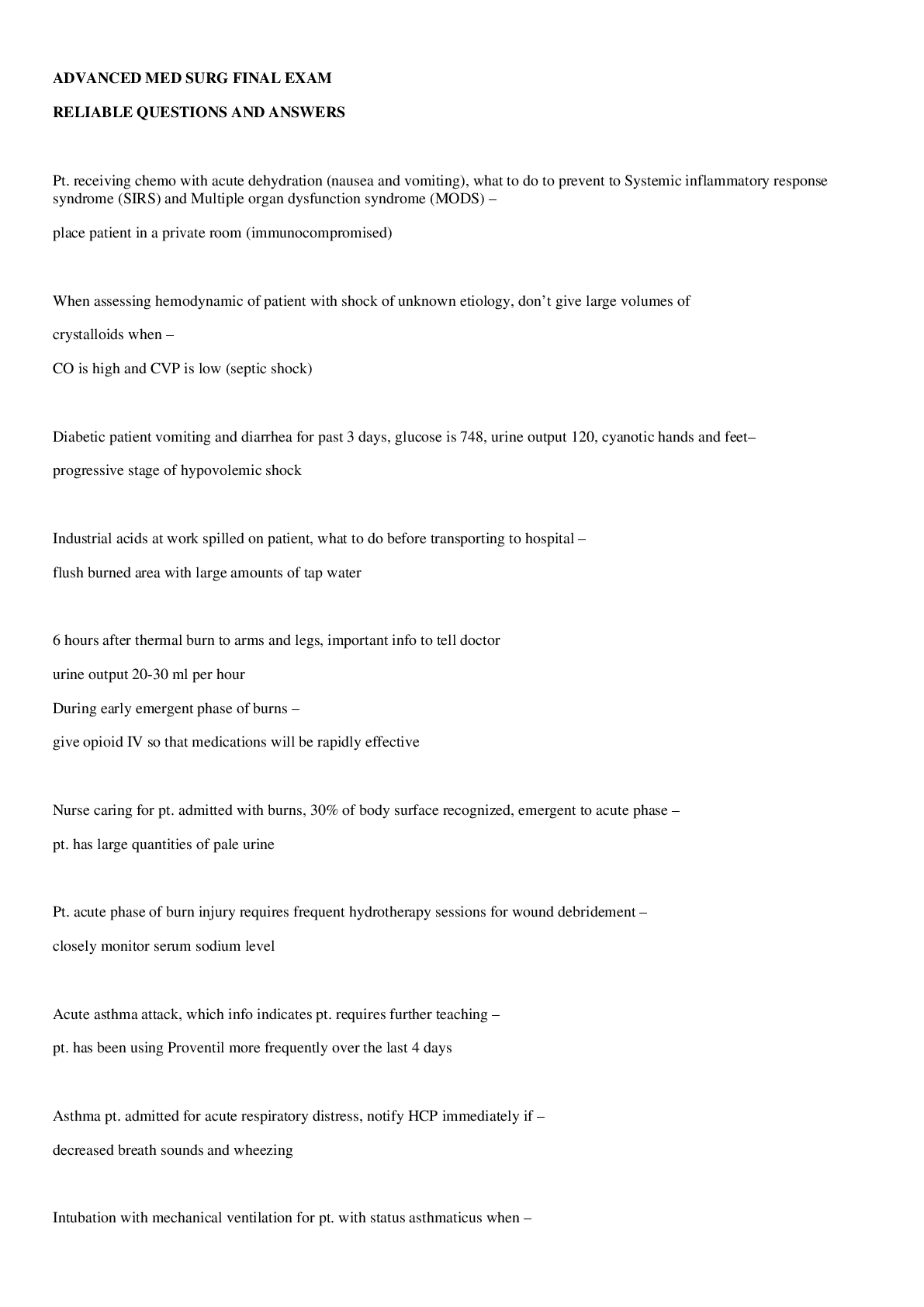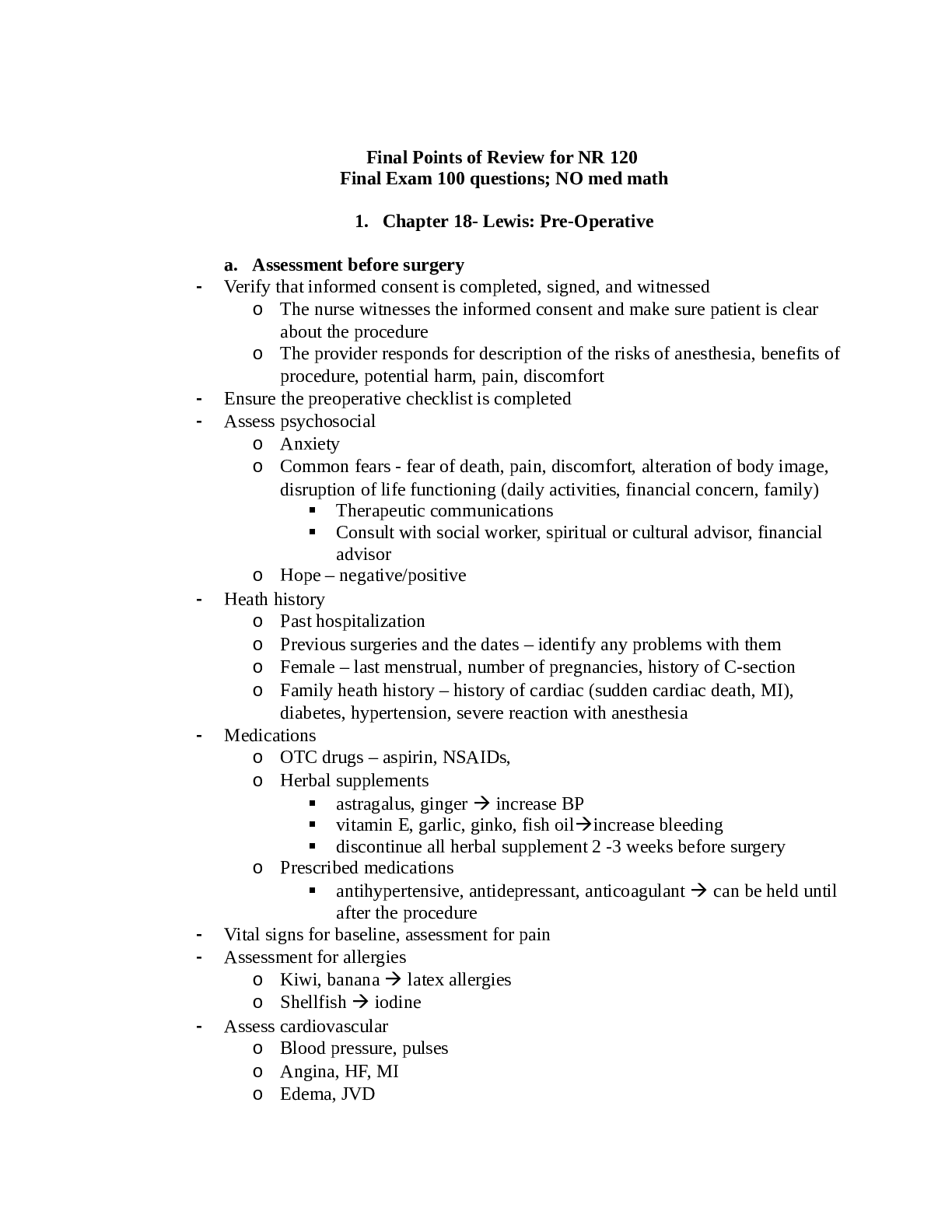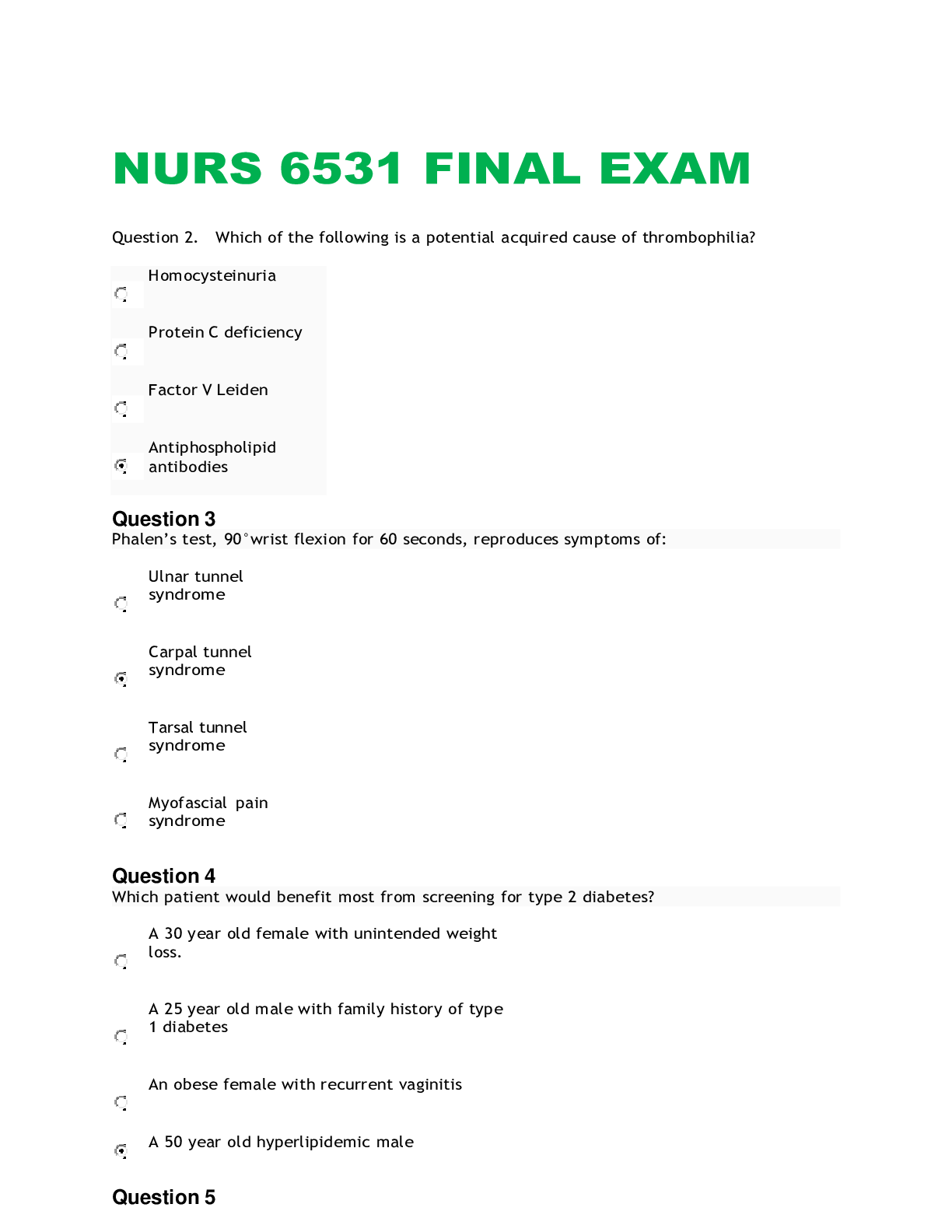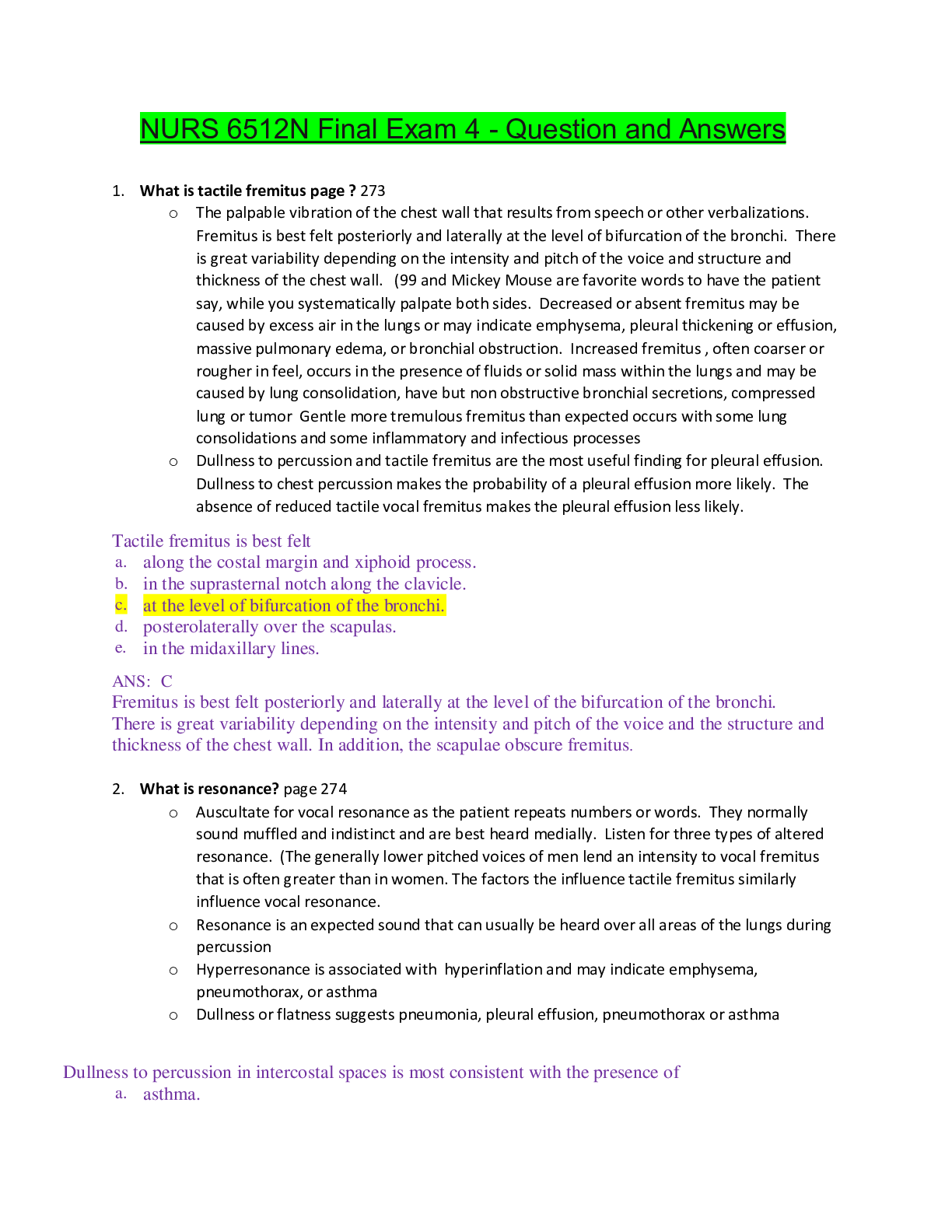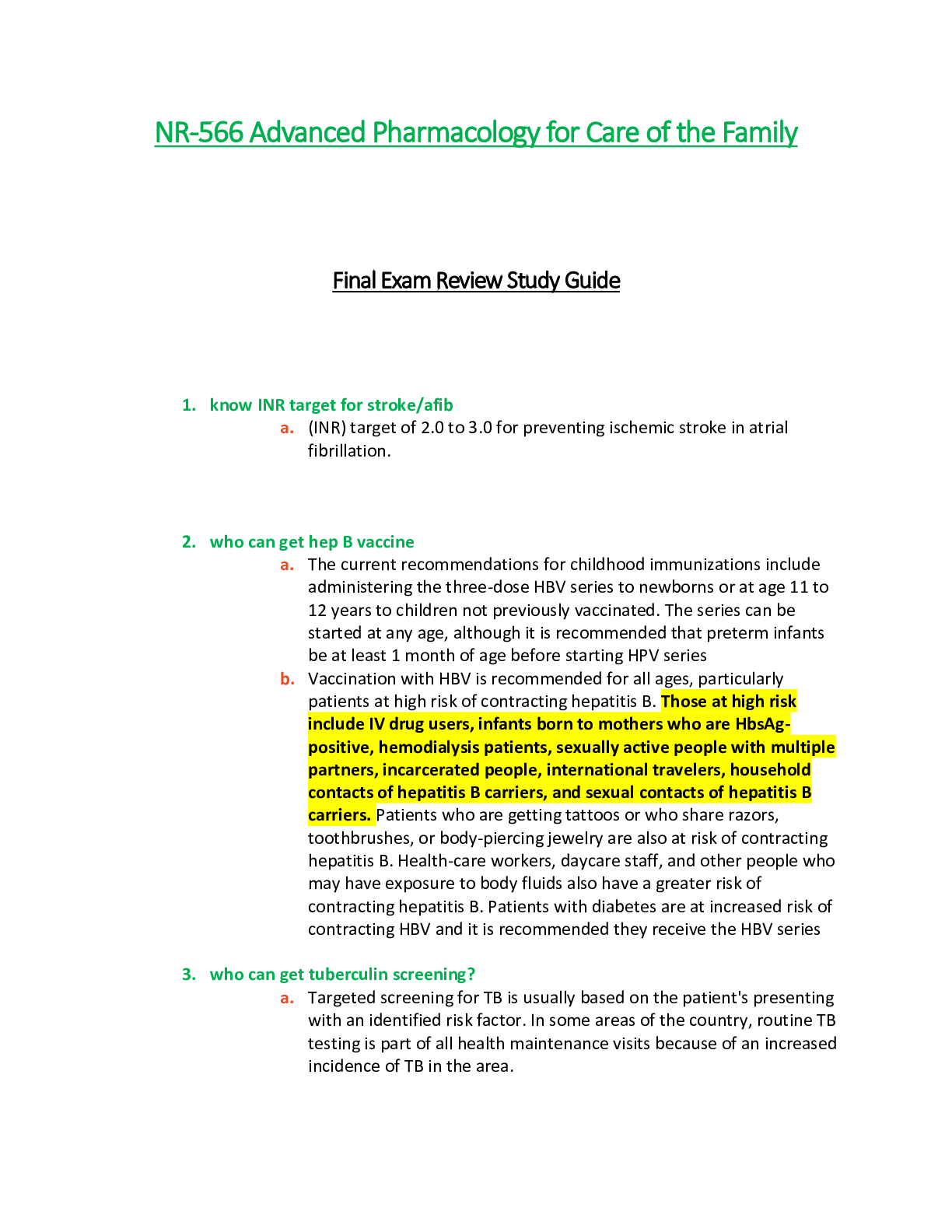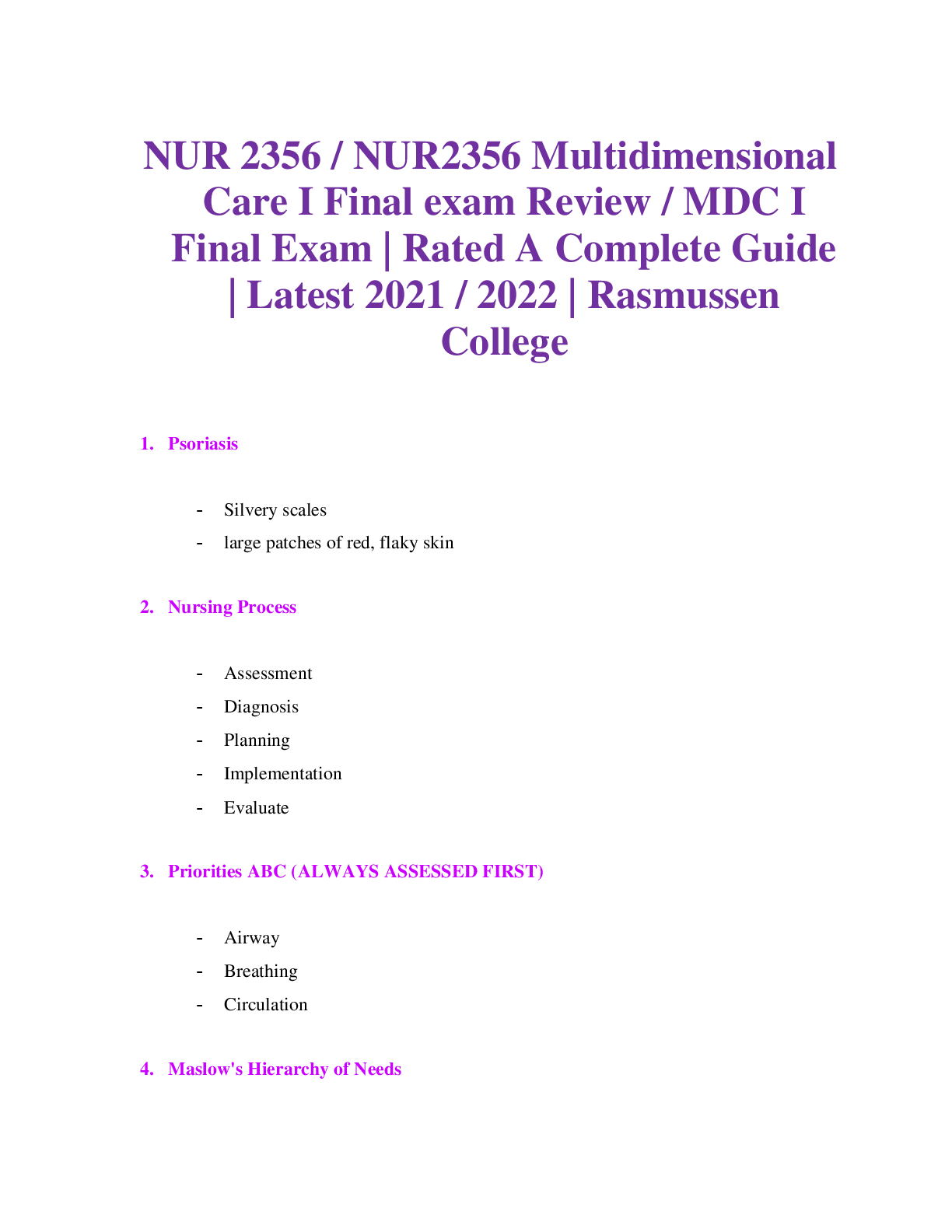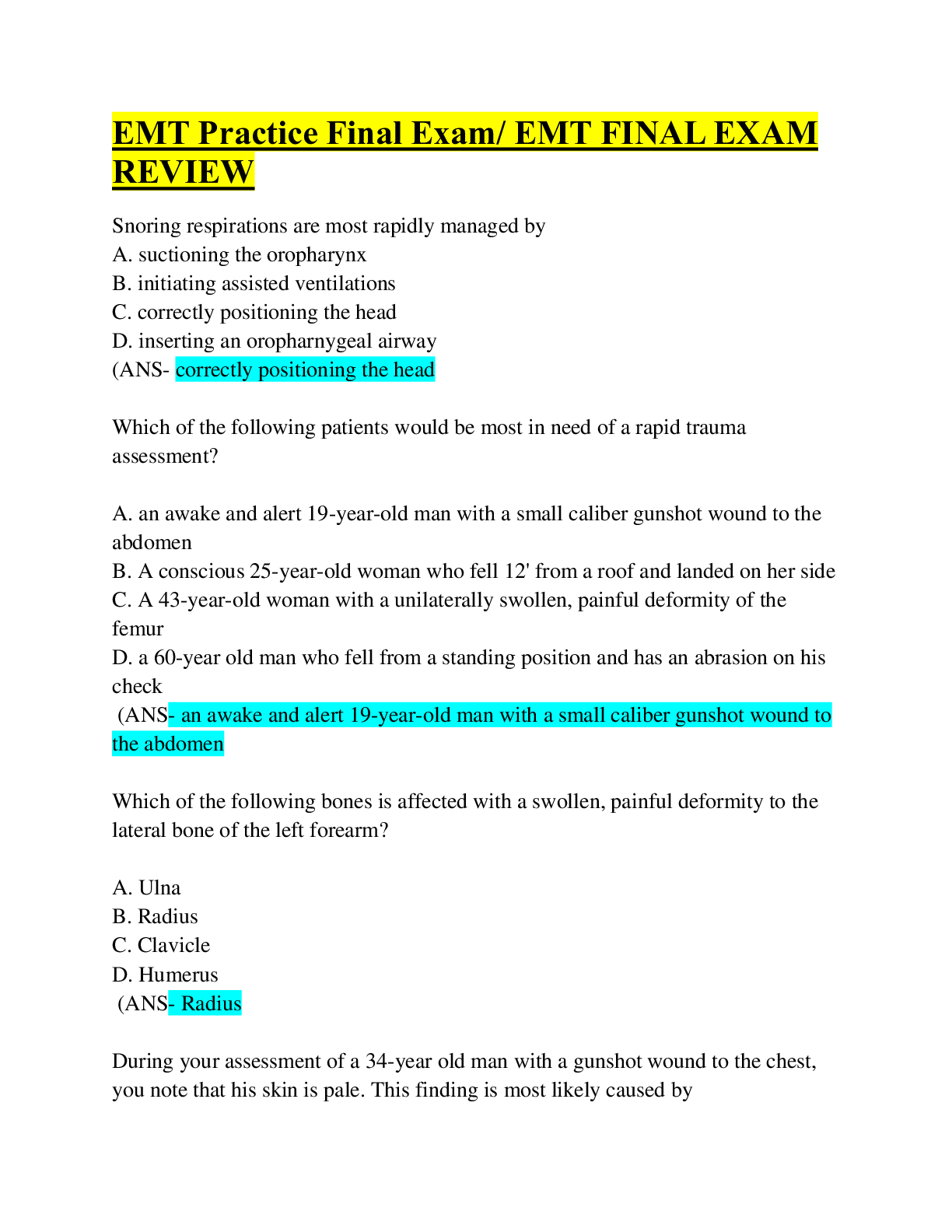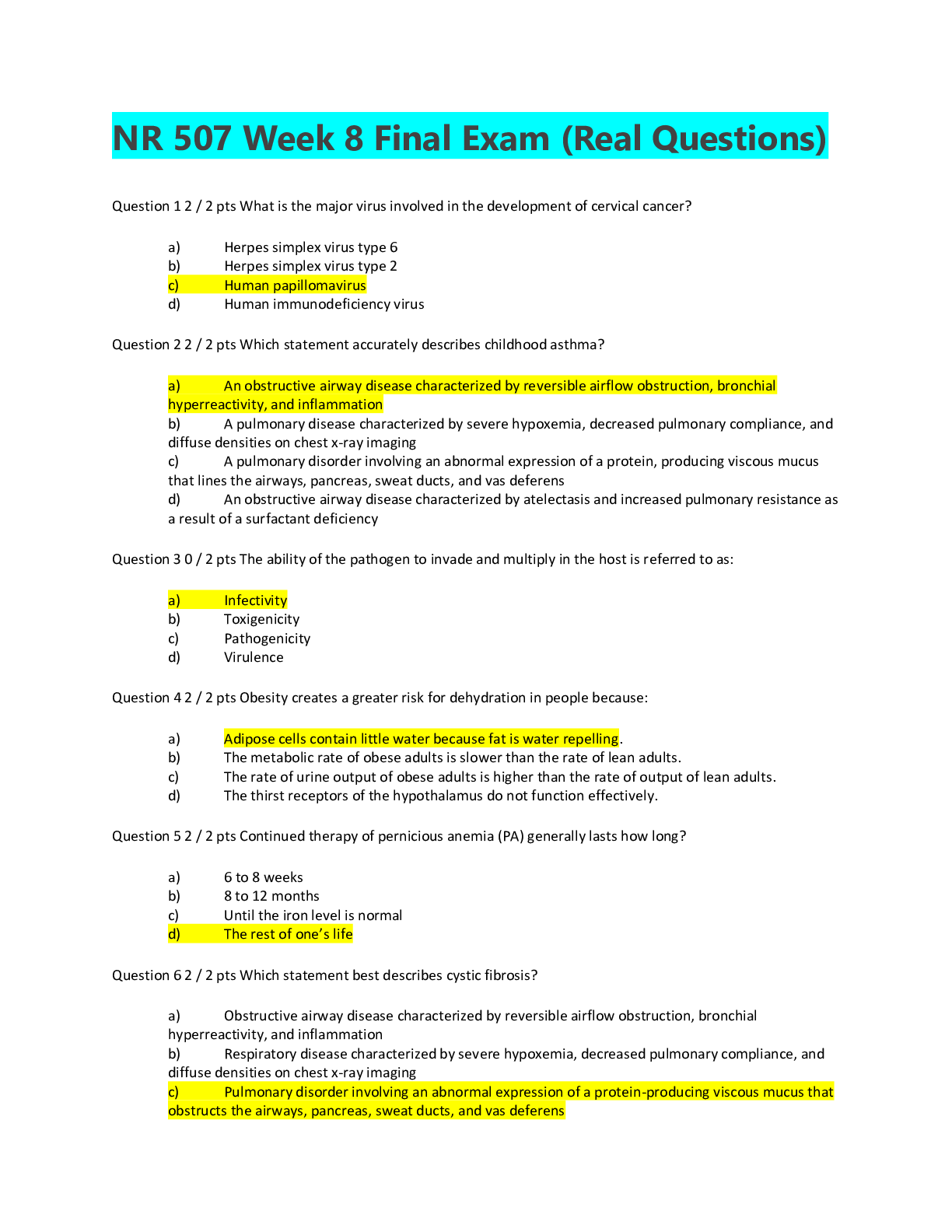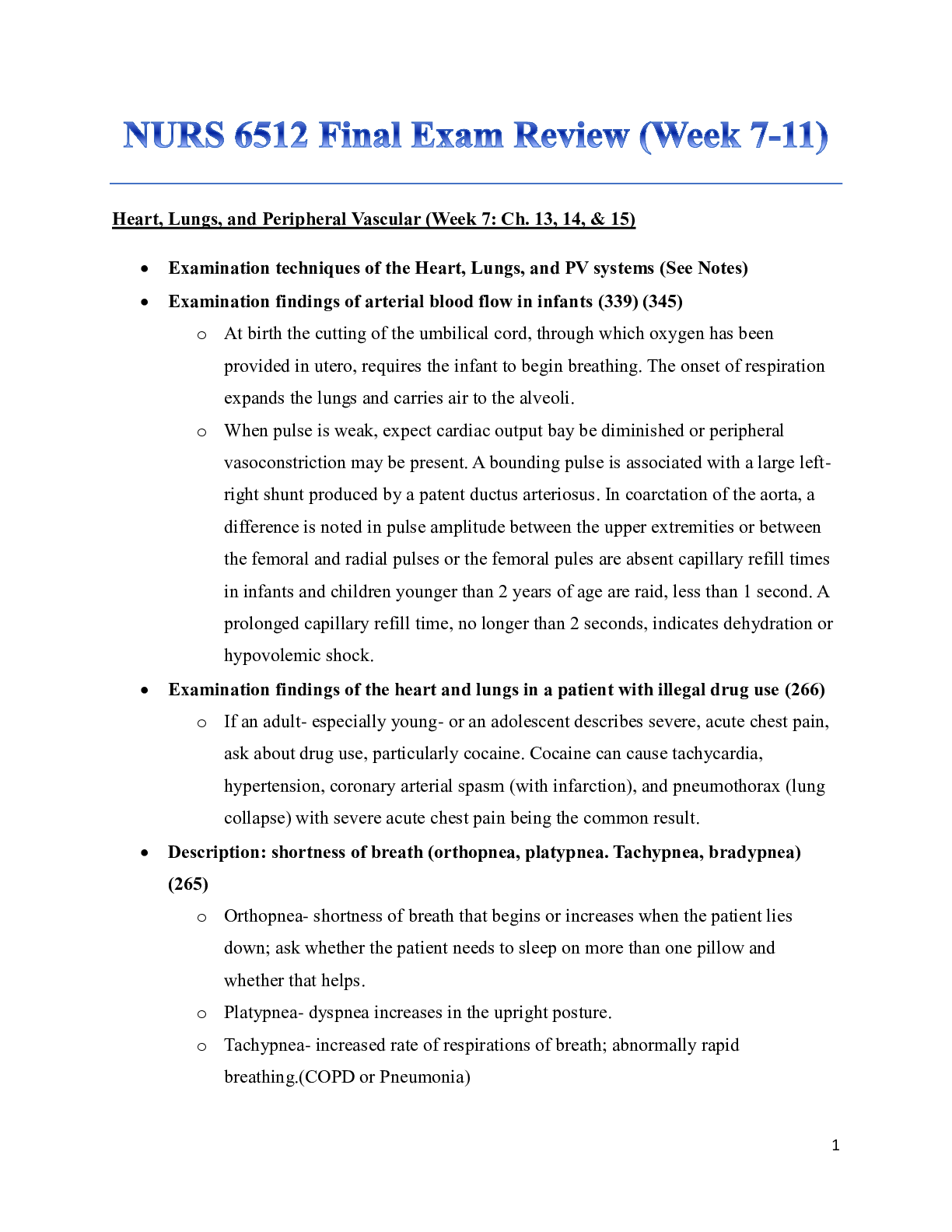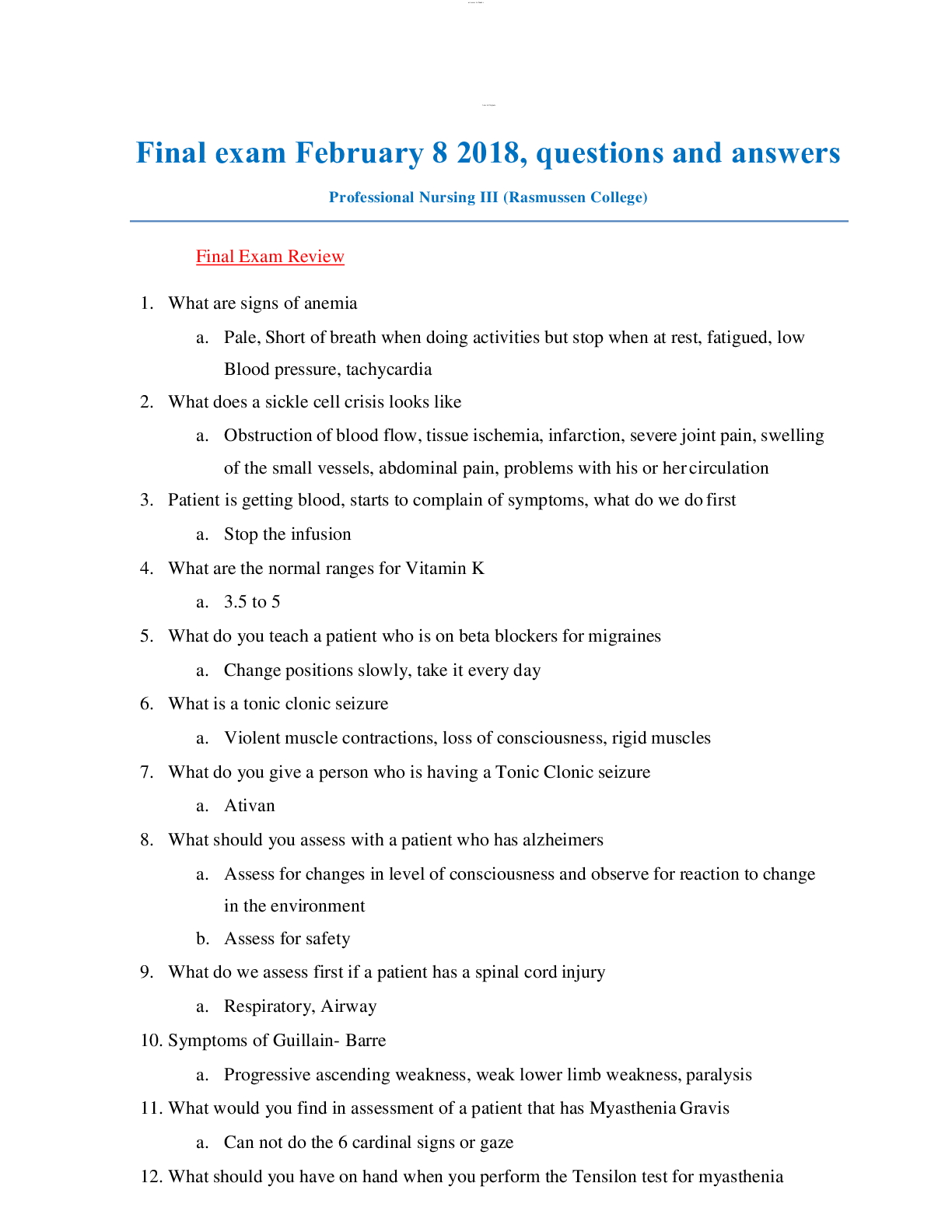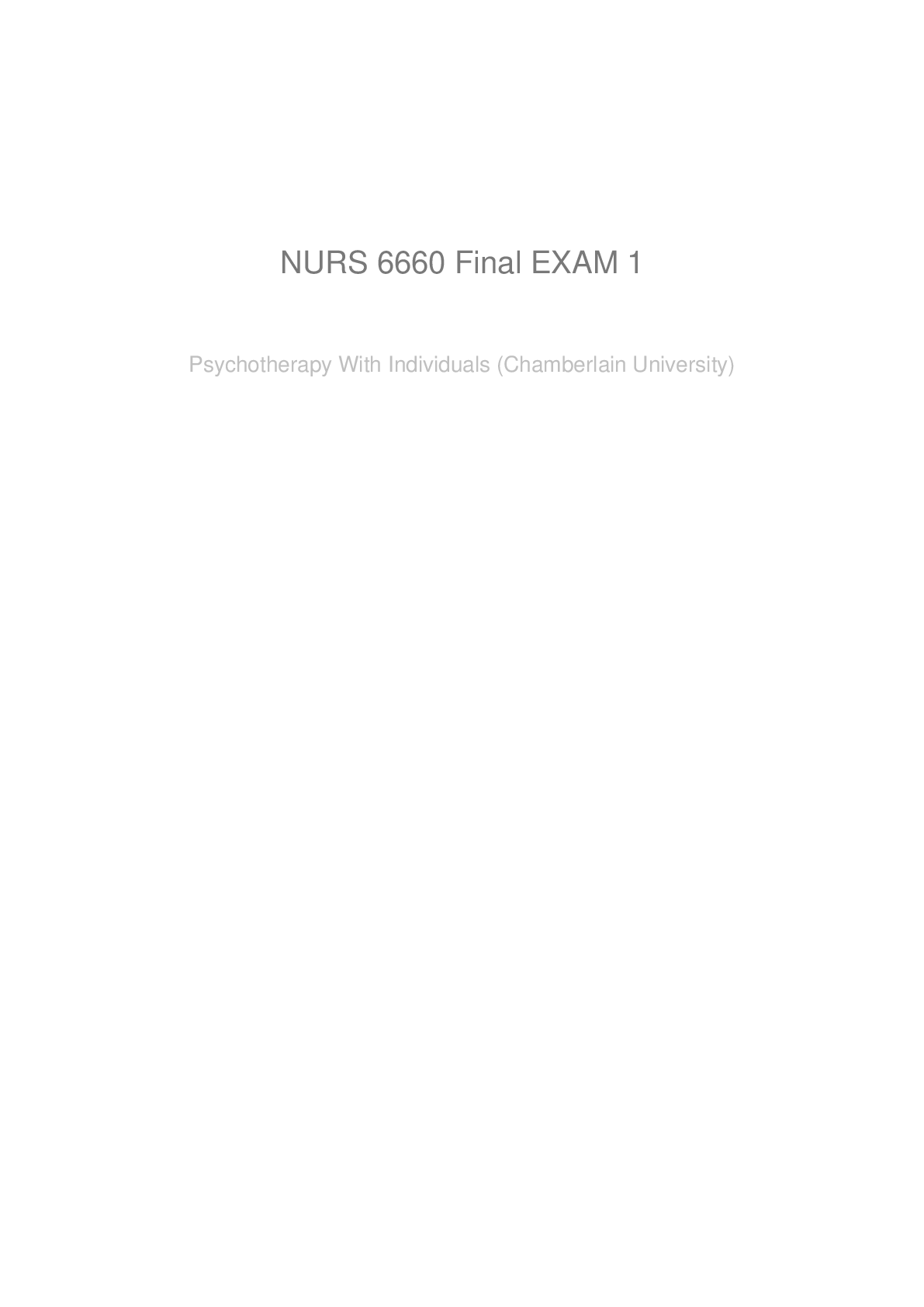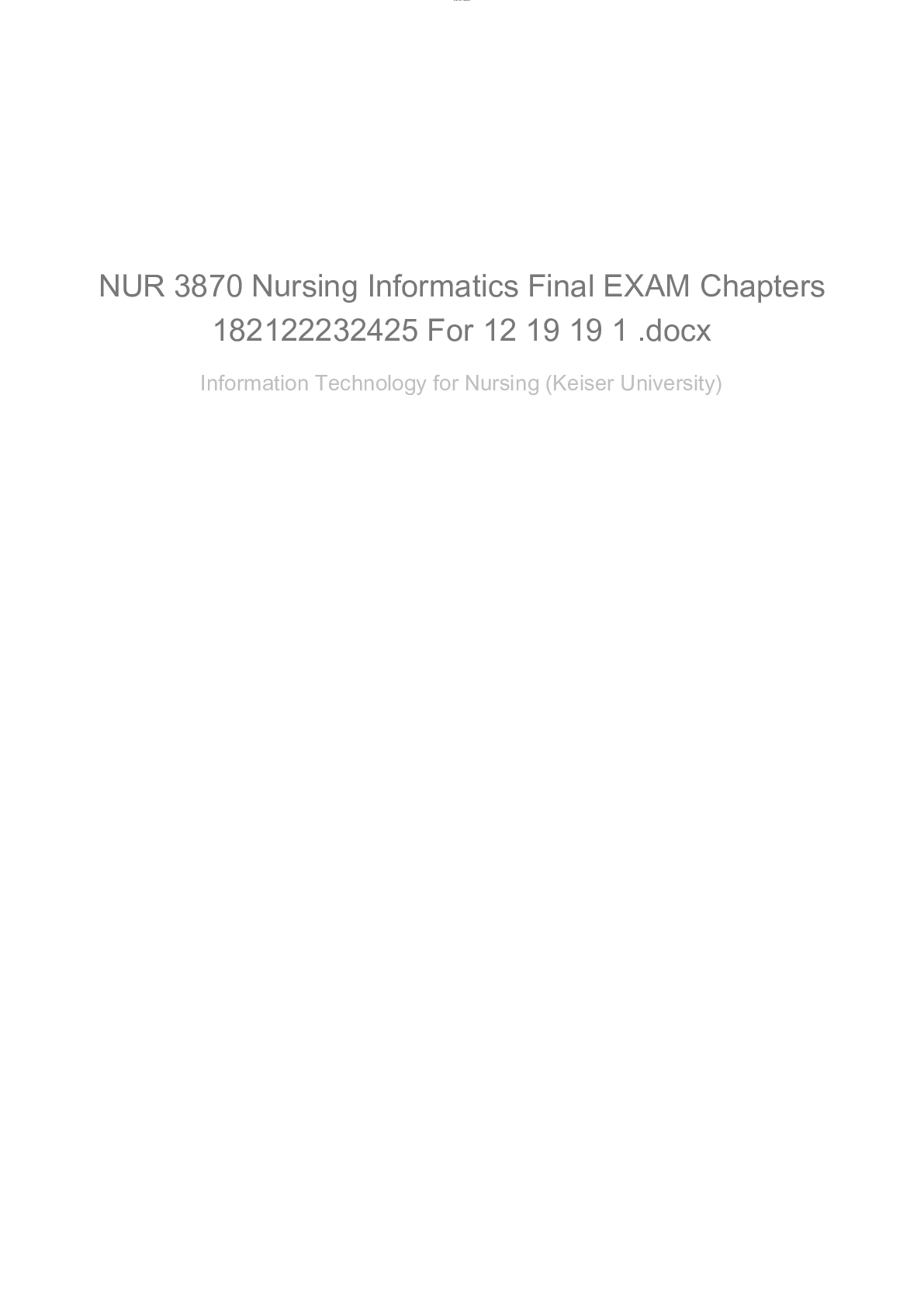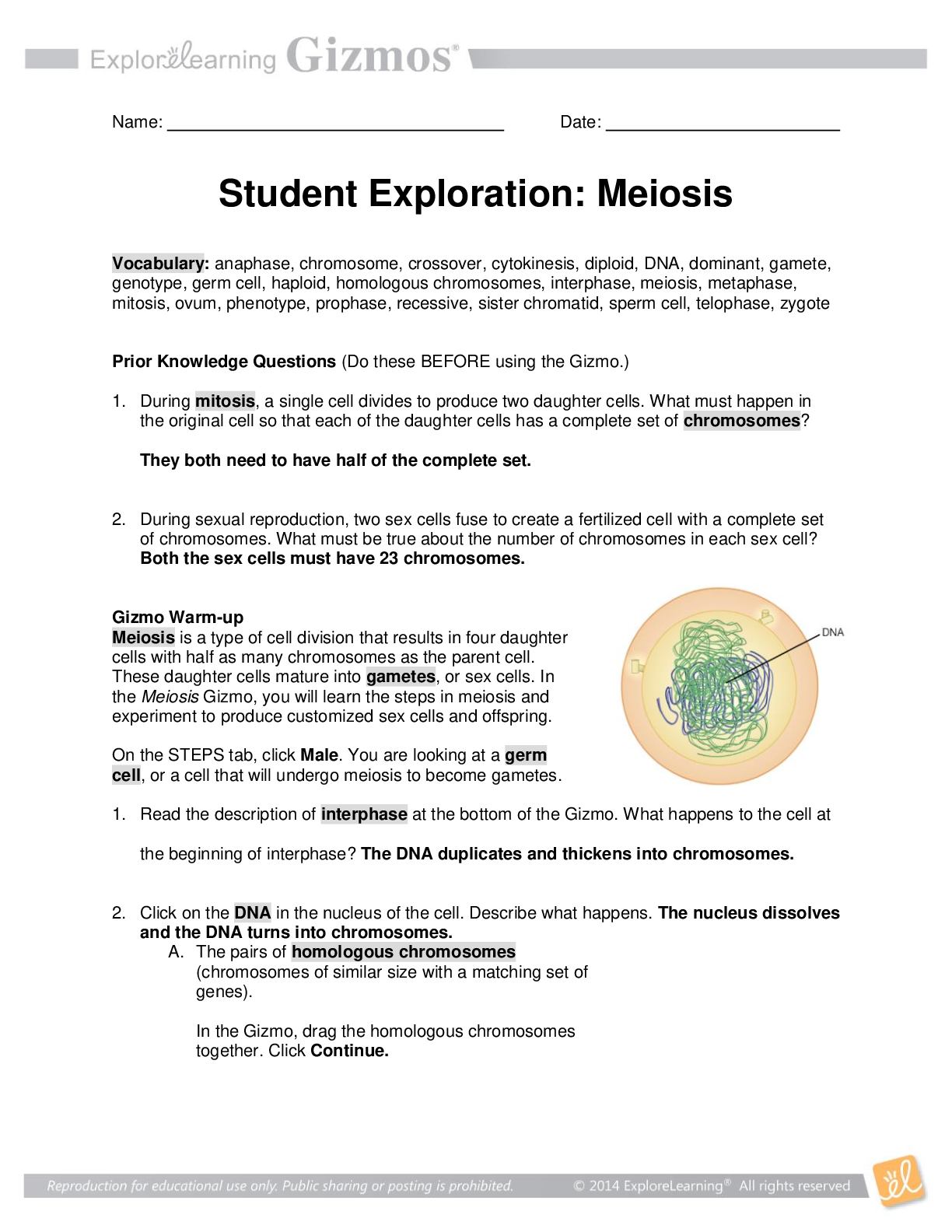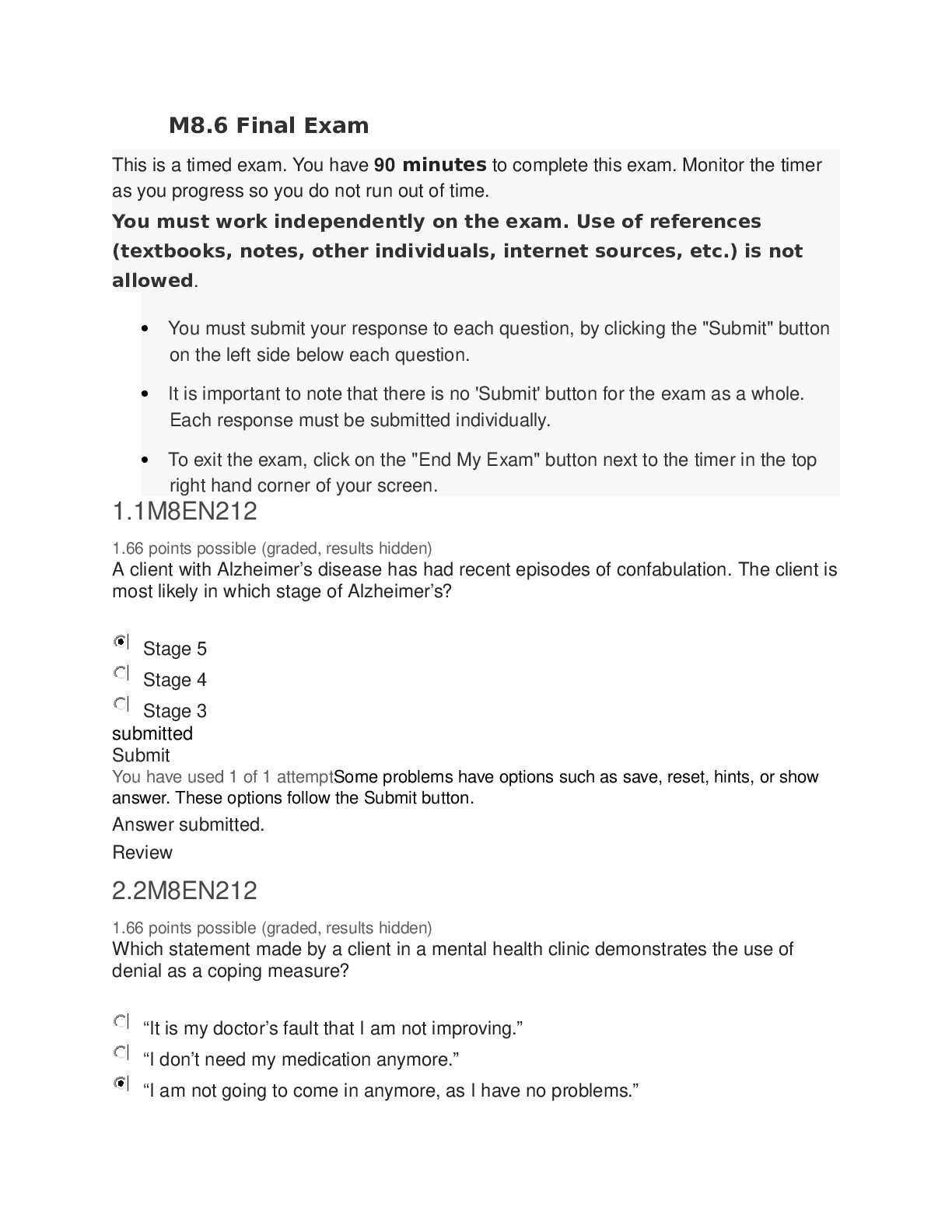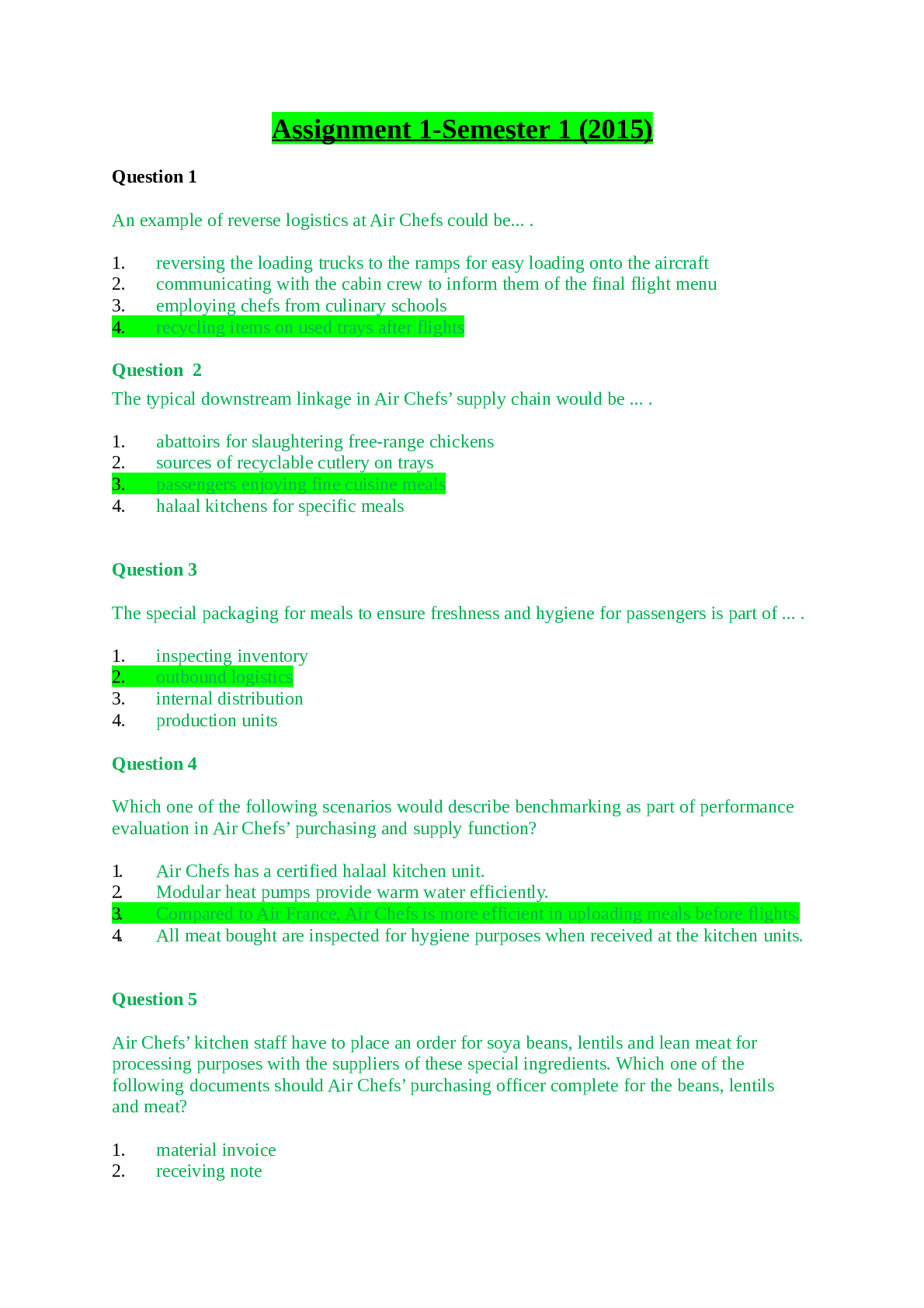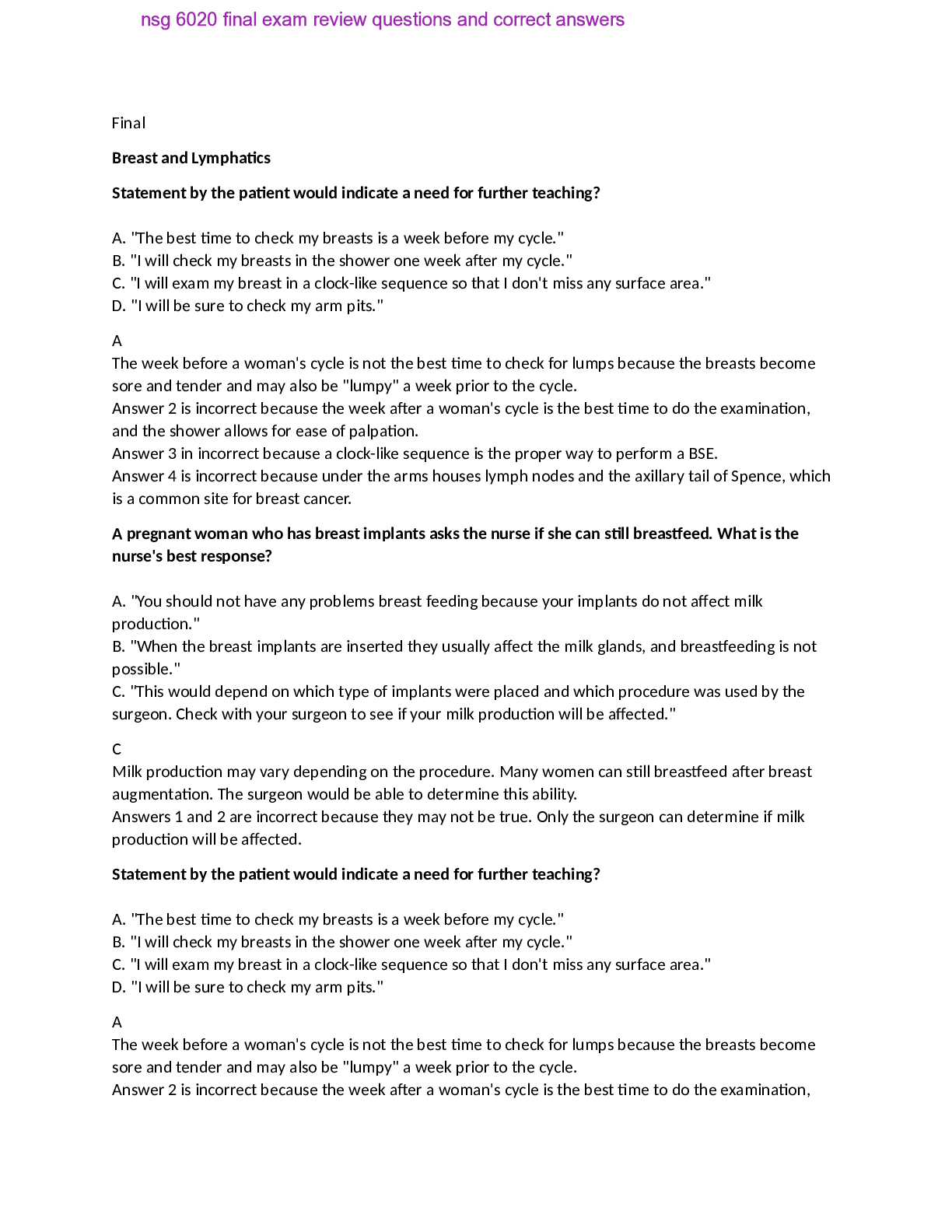*NURSING > Final Exam Review > FINAL REVIEW FOR MEDSURG COMPLETE (All)
FINAL REVIEW FOR MEDSURG COMPLETE
Document Content and Description Below
• Preoperative • Begins when the decision is made or surgery scheduled • Ends when the client is transferred to the operating room (OR) Obtain a detailed history Past health history: • Di... agnosed medical conditions (previous and current) • Allergies: Banana or Kiwi – indicative of latex allergy Eggs/Soybean – Donot give propofol Shellfish – No Iodine – Seafood – No Iodine • Previous surgeries and problems • Medication use • Substance abuse • Reactions/problems to anesthesia (patient or family) • Assess anxiety level and support systems • Lab results • Venous Thromboembolism risk : • Head to toe assessment, Vital signs, and O2 Sat • Pregnancy status • Chronic diseases etc DO 3 diagnostic test • Lab profile: PLEASE REVIEW ALL THE NORMAL VALUES • UA: r/o infections, Renal function • Blood type & cross-match: Ready for transfusion – Please go through procedure of blood transfusion – steps and other Nsg Responsibilities – ATI/Exam • CBC: Infection/immune status, • Hgb and Hct (fluid status, anemia) • Electrolytes • Kidney function (Serum Creatinine and BUN) • Pregnancy tests – Fetal risk for Anesthesia • Heart and Lung Status ( CXR) • 12 lead EKG: Baseline rhythm, dysrhythmias, cardiac disease)_ALL PATIENTS OLDER THAN 40 YEARS OLD Nursing Interventions Preoperative instructions: • Avoid cigarette smoking for 24 hr. preoperatively, • Medications to hold: • Acetylsalicylic acid (Aspirin): Stop 1 week before surgery. • Herbal medications (G’s: Ginkgo biloba, Ginseng, Garlic): stop taking 2 to 3 weeks before surgery to prevent hemorrhage. • Feverfew : Stop taking 2-3 weeks (adverse affects to the anesthetic) • Regular medications for chronic conditions maybe taken before surgery. • Bowel preparation instructions ( if needed) • Pain Scale • Intraoperative • Begins when the client is transferred to the OR • Ends when the client is transferred to a post anesthesia care unit (PACU) Risk Factors • General anesthesia: • Malignant hyperthermia • Respiratory disease ( hypoventilation) • Cardiac disease (dysrhythmias) • GI ( aspiration of gastric content) • Alcohol or drug use ( interactions) • Local anesthesia: • Allergy to ester-type anesthetics • Alterations in peripheral circulation • Airway patency is the main priority in all situations but cardiovascular problems can also arise • 3 phases: • Induction, Maintenance, Emergence. • Anesthetics used during general anesthesia are classified as: • Injectable : benzodiazepines, propofol ( don’t use with allergy to eggs or soybean oil), fentanyl. • inhaled (halothane, isoflurane). Antidotes - naloxone hydrochloride (Narcan) - Opioids flumazenil (Romazicon) - Benzodiazepines Anesthetics • Opoids – eg – Fentanyl, Sufentanil, Alfentanil • Uses – Sedation, Analgesics to releive post op and pre op pain. • Adverse effect – Depresses the CNS – Resp depression or distress • Delays regain of conscious after surgery • Can trigger N/V • Benzodiazepines – Eg- Diazepam, Midazolam • Uses: Reduce anxiety pre-op • Promote amnesia • Produce mild sedation with mod to little respiratory depression when titrated • Adv Effects – Cardiac/Resp arrest if not administered slowly or if doses are administered without waiting for full effect to develop Sedatives • Eg – Pentobarbital, Secobarbital • Uses – Sedative effect for preanesthesia sedation or amnesia effect • Induction of General Anesthesia • Adv Effect – Avoid giving within 14 days of starting or stopping MOA inhibitor, Respiratory depression • Neuromuscular blocking agents – Eg – Succinylcholine Vencuronium • Uses – Skeletal muscle relaxation for surgery • Airway placement • In conjunction with IV anesthetics agents • Adv Effects – Total flaccid paralysis • Requires mechanical ventilation because blocks contraction of muscles including the diaphragm and respiratory system. Antiemetics • Odensteron, Metoclopramide, Promethazine • Uses: Decrease post Anesthesia N/V • Metoclopramide – enhances gastric emptying • Promethazine – Induces sedation • Decreases risk of aspiration. • Adv Effects – Dry Mouth, Dizziness • Use metoclopramide with caution if history of parkinsonism disease and asthma • Promethazine can cause resp depression and apnea Anticholinergics • eg Atropine, Glycopyrolate • Uses: Decrease risk of Bradycardia during surgery and at times vagal slowing of the heart due to parasympathetic response to surgical manipulation • Block Muscarinic response to acetylcholine by decreasing salivation, bowel movement and GI secretions • Slow mobility of GI system • Decrease salivation, Pancreatic juices and gastric juices • Decrease risk of aspiration • Adv Effects – • Urinary retention • Tachycardia • Dry mouth • Decreased levodopa effects • Contraindicated with glaucoma and urinary problems Malignant Hyperthermia • Malignant Hyperthermia - • Acute life threatening medical emergency • Hypermetabolic condition causing an alteration in calcium activity in muscle cells – muscle rigidity and hyperthermia causing damage to CNS • Anesthetics – Trigger • Increased CO2 – Decreased O2 – Tachycardia – Dysrhythmias – Muscle Rigidity – Hypotension – Tachypea – skin mottling – cyanosis – muscle break down and myoglobinuria • Extremely High temperature – 111 F Nursing Actions for malignant hypothermia – • Terminate Surgery – Inform the Anethesiologist • Administer Dantrolene IV – relaxes muscles • O2 – 100 % - Monitor ABG – Met Acidosis • Iced – NS 0.9% • Cooling blanket • Monitor Urine output and BP Postoperative • Begins when client leaves the OR for the PACU • Ends when the client is transferred to Med-Surg Unit or discharged home (outpatient) • Who can transfer a client from OR to PACU? • Anesthesia provider (anesthesiologist or CRNA) • Circulating nurse gives the verbal “hand-off” report to PACU nurse. • Postoperative care is provided initially in the PACU by a ACLS certified RN. • Initial postoperative care: • assessments, administering medications, managing client’s pain, preventing complications, and determining when a client is ready to be discharged from the PACU. • PRIORITIES During the immediate postoperative stage: • airway patency • ventilation • circulatory status Common Post-OP Complications: Immediate to 48 hr: • Respiratory depression • Hypoxia • Wound Hemorrhage • Nausea • Shock • Urinary retention (up to 3days) First 48hr: • Atelectasis After 48 hr: • Hypostatic pneumonia 2-4 days: • Paralytic ileus (decreased peristalsis) 3-5 days: • Wound infection • > 4 days: • UTIs • Thrombophlebitis • Wound dehiscence/evisceration Risk FactorsUrinary retention (up to 3days) First 48hr: • Atelectasis After 48 hr: • Hypostatic pneumonia 2-4 days: • Paralytic ileus (decreased peristalsis) 3-5 days: • Wound infection • > 4 days: • UTIs • Thrombophlebitis • Wound dehiscence/evisceration Risk Factors for Postoperative complications • Immobility (respiratory compromise, thrombophlebitis, pressure ulcer) • Anemia (blood loss, inadequate/decreased oxygenation, and healing factors). • Hypovolemia (tissue perfusion). • Hypothermia (surgical wound infection, altered absorption of medication, coagulopathy, and cardiac dysrhythmia). • Cardiovascular diseases (fluid overload, deep-vein thrombosis, arrhythmia) • Respiratory disease (respiratory compromise) • Comorbidities affecting Post-Operative period: • Immune disorder (risk for infection, delayed healing) • Diabetes mellitus (gastroparesis, delayed wound healing) • Coagulation defect (increased risk of bleeding) • Malnutrition (delayed healing) • Obesity (wound healing, dehiscence, evisceration) • Older adults ( more susceptible) PACU Assessments and Nursing interventions: • Full Head to Toe assessment with priority given to airway, breathing, and circulation (ABCs) • Nursing monitoring and management: • Airway and Breathing: • ( artificial airway, O2 Sat (>92% or at preop. levels) • Respiratory pattern ,breath sounds, chest wall movement, and Auscultate lung sounds • Administer humidified oxygen. • If unable to cough: • Suctioning with Yankauer suction ( thick oral secretions), or • Large French suction catheter (nasopharyngeal or nasotracheal secretions) • Circulation: Monitor • S & S of internal bleeding (abdominal distention, visible hematoma under/near the surgical site, tachycardia, hypotension, increased pain). • External Bleeding. • Assess for hypervolemia and hypovolemia. • Assess skin color, temperature, sensation, and capillary refill. • Check mucous membranes, lips, and nail beds for cyanosis. • Assess and compare peripheral pulses for impaired circulation, deep-vein thrombosis (continue DVT prevention measures) • ECG readings and apical pulse Fluid and electrolyte balance. • Vital Signs: • Until stable (every 15 min) and assess for trends. • Prevent hypothermia • Positioning: • If responding to verbal stimuli: Semi Fowler’s if not contraindicated (facilitate chest expansion) • If unresponsive or unconscious: Right or Left Lateral position (to prevent aspiration) • If hypotension or shock develop: Elevate legs and lower the head of the bed. • If recovering from spinal anesthesia: Do not elevate legs higher than placement on a pillow • Avoid placing a pillow under the knees or engaging the knee gatch of the bed ( decrease venous return). • Response to anesthesia (sedation, nausea and/or vomiting), Monitor • LOC • Movement, sensation • Antiemetics • I & O: Monitor • Fluid and electrolyte balance • Skin turgor, diaphoresis • Emesis, drains, NG tubes, IV fluids, urine, Blood products. • Isotonic IV fluids (0.9% sodium chloride, lactated Ringer’s, dextrose 5% in lactated Ringer’s) • Palpate bladder for distention. • Urinary catheters patency: Urine output less than 30 mL/hr may indicate hypovolemia. • Surgical wound, incision site, and/or dressing • Pain • Monitor recovery from anesthesia by using the Aldrete scoring system. • Criteria indicating readiness for discharge from the PACU • Aldrete Score of 8 to 10 • Stable vital signs • No evidence of bleeding • Return of reflexes (gag, cough, swallow) • Minimal to absent nausea and vomiting • Wound drainage that is minimal to moderate • Urine output of at least 30 mL/hr • The anesthesiologist must sign out the client before transfer to another unit or discharged to home. DIABETES • Type 2 – Impaired insulin production/Impaired insulin use Etiology and Risk Factors • Type 2 – • Insulin production is less or use is impaired or reduces insulin sensitivity o Hereditary – major role o Obesity o Eating habits o Sedentary life style Pathophysiology • Type 2 – • Causes – leading to high glucose • Stages – Desensitization – Failure of beta cells to respond to high glucose levels • Insulin Resistance – Production of glucose by liver despite of high glucose levels • Inability of fat and muscle tissue to take up glucose – peripheral insulin resistance Clinical Manifestations • 3 p’s – Polydipsia, Polyuria and Polyphagia • ^ Hyperglycemia S/S: Fatigue, Blurred vision, Slow wound healing, Itchy skin-“Hot and dry, blood sugar high” • v Hypoglycemia S/S: Sweating, Hunger, Trembling, Anxiety, Confusion, Blurred vision-“Cool and clammy, need some candy” • Weight loss • Ketone bodies- Diabetic Keto Acidosis • Fruit breath odor, headache, N,V, Abd. Pain, fatigue, weakness, slow wound healing To diagnose Diagnostic criteria include: • TWO findings (on separate days) of at [Show More]
Last updated: 1 year ago
Preview 1 out of 121 pages

Reviews( 0 )
Document information
Connected school, study & course
About the document
Uploaded On
Jul 04, 2021
Number of pages
121
Written in
Additional information
This document has been written for:
Uploaded
Jul 04, 2021
Downloads
0
Views
58


